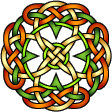 Mac
Leod
Mac
Leod

of Mac
Leod |
While so many Highland
strongholds lie in ruins today, Dunvegan Castle
in Skye, the seat of the chiefs of Siol Tormoid,
has been occupied by them for twenty generations
during seven centuries. It is therefore of some
interest to notice what its muniments do and do
not include. There are no title deeds from the
King of Scots to whom the islands were ceded in
1266 by the Norwegians under the Treaty of Perth,
none from King Robert Bruce whom the Mac Leods
supported, a charter for Glenelg on the mainland
only from his son David II, none that survive
from the days of the Lordship of the Isles, whose
vassals the Mac Leods found themselves to be by
the stroke of a distant pen. After the fall of
the Lordship in 1498 Mac Leod of Dunvegan at last
received a charter from the crown, but not for
all the possessions that were rightfully his so
when successive Stewart sovereigns summoned the
Highland chiefs to show the titles to their
lands, what did they expect them to exhibit when
even the Lords of Dunvegan had been denied proper
titles? It was the appalling ineptitude of the
central government that compelled clans to fight
for their home-acre, just as the Mac Leods in
Skye had to fight a losing battle against the Mac
Donalds of Sleat for their lands of Trotternish.
But in the time of troubles
occasioned by the dismantling of the Lordships,
the punitive policies of James IV and James V,
and the powers given to the Campbells and the
Gordons. Dunvegan was extremely fortunate in the caliber of it's 8th Chief. He was known as
Alasdair Crotach (Hump-backed Alexander) as the
result of an injury. Although he supported the
claimants to the Lordship after its abolition, he
succeeded in extricating himself when James V
made his expedition to the Hebrides, seizing and
imprisoning chiefs on his journey. He even
secured a charter to the disputed lands of
Trotternish in 1542, the year of James V's death.
But it is in the cultural field that Alasdair
Crotach is to be remembered especially. He
rebuilt the church of Rodel in Harris, the finest
that remains in the outer Hebrides, where his
tomb is an outstanding example of the monument
sculpture of the period. He built the Fairy Tower
at Dunvegan, its finest building, and he is said
to have been judged largely by the criminal
records (often faked) of a distant government
that knew nothing of its arts or literature.
Dunvegan was to blossom as a centre of these arts
after the patronage of the Lordship was
destroyed. Here the Beatons came with their
ancient learning. Here the new music of pibroch
was developed by the Mac Crimmons. Here the most
famous Gaelic harper, Roderick Morrison, found
his audience.
This achievement is associated
particularly with Sir Roderick Mac Leod of Mac
Leod the 15th Chief, known as Ruaraidh Mor. He
died in 1626 and is immortalised by Patrick Mor
Mac Crimmon's lament. By then the Franciscan
missionary Cornelius Ward had visited Skye,
received Ruaraidh Mor's encouragement to
proselytize, and reported to Rome that he was
"a very lordly ruler"and a devout
Catholic. It is thought that Mary Mac Leod was by
then a girl of ten, already in his household at
Dunvegan. The simple, lovely language of her
poetry has preserved the freshest picture that
remains of the society whose passing the Blind
Harper, Roderick Morrison, was to lament.
The Mac Leods supported
Charles I in the Civil War, and their contingent
of about 700 men was annihilated at Worcester,
fighting for Charles II in 1651. Stewart
ingratitude, and conversion to Calvinism,
combined to hold the Mac Leods aloof from the
Jacobite risings, so that Boswell and Johnson
found the old patriarchal society still intact
here when the 22nd Chief entertained them at
Dunvegan in 1773. |
|
|



